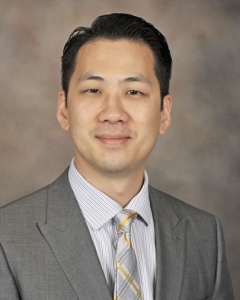Keck Medicine of USC vascular surgeons are the only surgeons in Southern California using a new robotic system with the potential to reduce procedure times, decrease radiation, shorten hospital stays, enhance safety and put patients back on their feet again faster.
Whittier resident Paul Toft, 59, was one of the first patients at Keck Medicine of USC to benefit from the new system being used by surgeons at the USC CardioVascular Thoracic Institute, part of Keck Medicine of USC. Sung Wan Ham, MD, director of the Endovascular Robotic Program and his team, including Fred Weaver, MD, MMM, chief of vascular surgery and endovascular therapy, and Sugku Han, MD, assistant professor of surgery at Keck Medicine of USC, performed the surgery in late September.
Toft, a high school mathematics teacher who had been in good health all of his life, began suffering last summer from blockage of the left superficial femoral artery. The blockage cut off oxygen to his lower left leg, causing severe leg cramps and endangering the leg.
“As a teacher, I’m constantly moving, but I couldn’t walk a city block without needing rest,” he said. “My general practitioner told me I needed to get help or I was likely to lose my lower leg.”
Toft’s surgery was performed with the Magellan Robotic System by Hansen Medical Inc., a robotic endovascular system used to treat peripheral vascular disease (PVD) more efficiently and effectively, with shorter procedure times and less radiation exposure to the patient and surgery staff.
“The operation took an hour and a half, and I was out of the hospital by noon the next day,” Toft said.
PVD, also known as peripheral arterial disease (PAD), includes diseases of blood vessels outside of the brain and heart and refers to narrowing or blockage of such vessels with plaque.
According to the National Institutes of Health, PAD affects 8-12 million people in the United States, especially people over age 50.
“Thanks to my GP and Dr. Sung Wan Ham, who performed my surgery, I feel no restrictions,” Toft said. “I can walk and run for miles and do everything I want to do.”
Radiation is employed in endovascular surgery to help the surgeon see the catheter and move it safely through blood vessels. Radiation exposure varies depending on the procedure. For Toft’s procedure, without robotic surgery radiation exposure would typically be 30 minutes. With robotic surgery, the exposure was decreased to 20 minutes.
Keck Medicine of USC recently acquired two Magellan Robotic Systems and has plans to serve as a regional Center of Excellence to help train other physicians in the region on use of this emerging technology.
The robotic system was cleared by the federal Food and Drug Administration for navigation to anatomical targets in peripheral blood vessels in 2012.
— Leslie Ridgeway


